check engine YAMAHA YZF-R6 2001 Owners Manual
[x] Cancel search | Manufacturer: YAMAHA, Model Year: 2001, Model line: YZF-R6, Model: YAMAHA YZF-R6 2001Pages: 118, PDF Size: 12.83 MB
Page 18 of 118
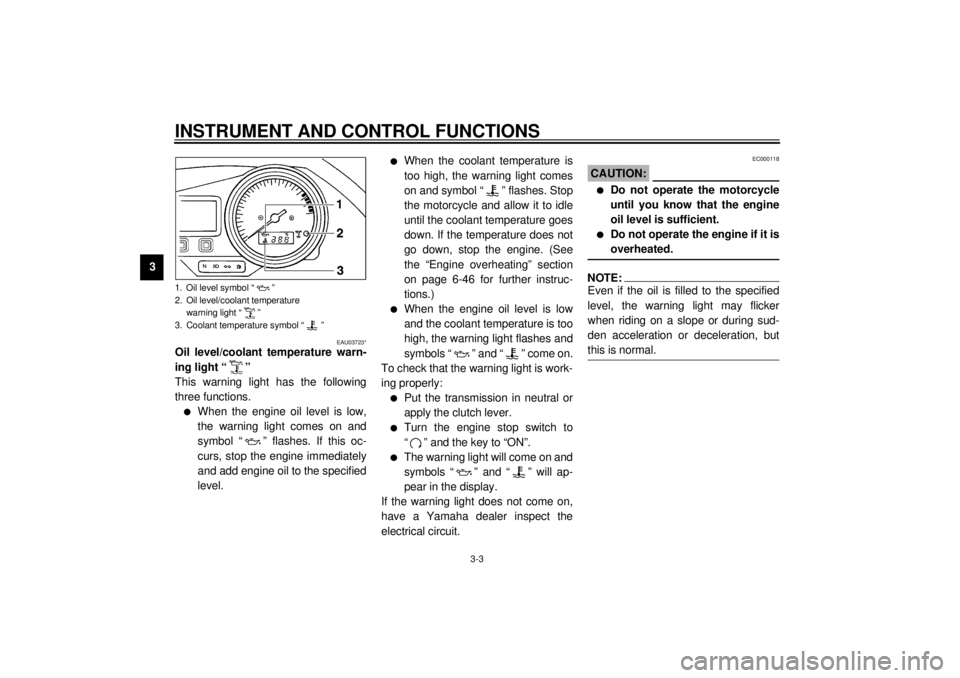
INSTRUMENT AND CONTROL FUNCTIONS
3-3
3
EAU03723*
Oil level/coolant temperature warn-
ing light “ ”
This warning light has the following
three functions.l
When the engine oil level is low,
the warning light comes on and
symbol “ ” flashes. If this oc-
curs, stop the engine immediately
and add engine oil to the specified
level.
l
When the coolant temperature is
too high, the warning light comes
on and symbol “ ” flashes. Stop
the motorcycle and allow it to idle
until the coolant temperature goes
down. If the temperature does not
go down, stop the engine. (See
the “Engine overheating” section
on page 6-46 for further instruc-
tions.)
l
When the engine oil level is low
and the coolant temperature is too
high, the warning light flashes and
symbols “ ” and “ ” come on.
To check that the warning light is work-
ing properly:
l
Put the transmission in neutral or
apply the clutch lever.
l
Turn the engine stop switch to
“ ” and the key to “ON”.
l
The warning light will come on and
symbols “ ” and “ ” will ap-
pear in the display.
If the warning light does not come on,
have a Yamaha dealer inspect the
electrical circuit.
EC000118
CAUTION:_ l
Do not operate the motorcycle
until you know that the engine
oil level is sufficient.
l
Do not operate the engine if it is
overheated.
_NOTE:_ Even if the oil is filled to the specified
level, the warning light may flicker
when riding on a slope or during sud-
den acceleration or deceleration, but
this is normal. _
1. Oil level symbol “ ”
2. Oil level/coolant temperature
warning light “ ”
3. Coolant temperature symbol “ ”E_5mt_Functions.fm Page 3 Thursday, September 21, 2000 10:27 AM
Page 22 of 118
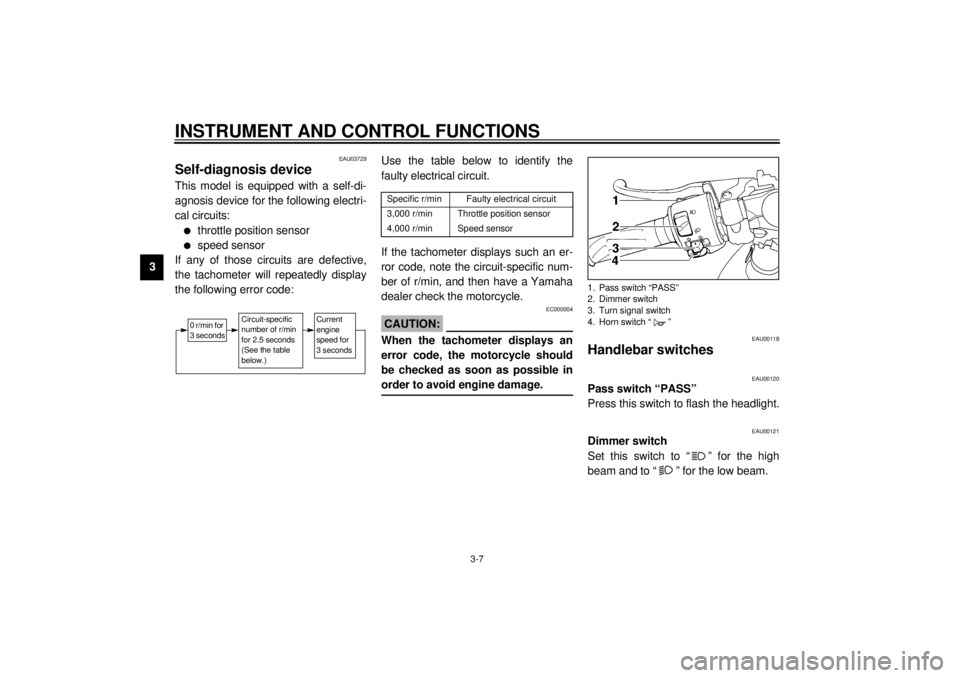
INSTRUMENT AND CONTROL FUNCTIONS
3-7
3
EAU03729
Self-diagnosis device This model is equipped with a self-di-
agnosis device for the following electri-
cal circuits:l
throttle position sensor
l
speed sensor
If any of those circuits are defective,
the tachometer will repeatedly display
the following error code:
CB-11E
Use the table below to identify the
faulty electrical circuit.CB-28EIf the tachometer displays such an er-
ror code, note the circuit-specific num-
ber of r/min, and then have a Yamaha
dealer check the motorcycle.
EC000004
CAUTION:_ When the tachometer displays an
error code, the motorcycle should
be checked as soon as possible in
order to avoid engine damage. _
EAU00118
Handlebar switches
EAU00120
Pass switch “PASS”
Press this switch to flash the headlight.
EAU00121
Dimmer switch
Set this switch to “ ” for the high
beam and to “ ” for the low beam.
0 r/min for
3 seconds
Circuit-specific
number of r/min
for 2.5 seconds
(See the table
below.)
Current
engine
speed for
3 seconds
Specific r/min
Faulty electrical circuit
3,000 r/min
Throttle position sensor
4,000 r/min
Speed sensor
1. Pass switch “PASS”
2. Dimmer switch
3. Turn signal switch
4. Horn switch “ ”
E_5mt.book Page 7 Monday, September 18, 2000 9:08 AM
Page 38 of 118

INSTRUMENT AND CONTROL FUNCTIONS
3-23
3
EAU03720
Ignition circuit cut-off system The ignition circuit cut-off system (com-
prising the sidestand switch, clutch
switch and neutral switch) has the fol-
lowing functions.l
It prevents starting when the trans-
mission is in gear and the side-
stand is up, but the clutch lever is
not pulled.
l
It prevents starting when the trans-
mission is in gear and the clutch
lever is pulled, but the sidestand is
still down.
l
It cuts the running engine when
the transmission is in gear and the
sidestand is moved down.
Periodically check the operation of the
ignition circuit cut-off system according
to the following procedure.
EW000045
WARNING
_ If a malfunction is noted, have a
Yamaha dealer check the system
before riding. _E_5mt.book Page 23 Monday, September 18, 2000 9:08 AM
Page 39 of 118

INSTRUMENT AND CONTROL FUNCTIONS
3-24
3
CD-01E
With the engine turned off:
1. Move the sidestand down.
2. Make sure that the engine stop switch is set to “ ”.
3. Turn the key to “ON”.
4. Shift the transmission into the neutral position.
5. Push the start switch.
Does the engine start?
The neutral switch may be defective.
The motorcycle should not be ridden until
checked by a Yamaha dealer.
With the engine still running:
6. Move the sidestand up.
7. Keep the clutch lever pulled.
8. Shift the transmission into gear.
9. Move the sidestand down.
Does the engine stall?After the engine has stalled:
10. Move the sidestand up.
11. Keep the clutch lever pulled.
12. Push the start switch.
Does the engine start?
The sidestand switch may be defective.
The motorcycle should not be ridden until
checked by a Yamaha dealer.The clutch switch may be defective.
The motorcycle should not be ridden until
checked by a Yamaha dealer.
NO
NOTE:This check is most reliable if performed with
a warmed-up engine.
YESYES NO
The system is OK.
The motorcycle can be ridden.
YES NO
E_5mt.book Page 24 Monday, September 18, 2000 9:08 AM
Page 42 of 118

4-1
4
EAU01114
4-PRE-OPERATION CHECKSThe condition of a vehicle is the owner’s responsibility. Vital components can start to deteriorate quickly and unexpectedly,
even if the vehicle remains unused (for example, as a result of exposure to the elements). Any damage, fluid leakage or loss
of tire air pressure could have serious consequences. Therefore, it is very important, in addition to a thorough visual inspec-
tion, to check the following points before each ride.
EAU03439
Pre-operation check list
CO-01E
ITEM CHECKS PAGE
Fuel• Check fuel level in fuel tank.
• Refuel if necessary.
• Check fuel line for leakage.3-11–3-12
Engine oil• Check oil level in engine.
• If necessary, add recommended oil to specified level.
• Check vehicle for oil leakage.6-10–6-13
Coolant• Check coolant level in reservoir.
• If necessary, add recommended coolant to specified level.
• Check cooling system for leakage.6-13–6-17
Front brake• Check operation.
• If soft or spongy, have Yamaha dealer bleed hydraulic system.
• Check fluid level in reservoir.
• If necessary, add recommended brake fluid to specified level.
• Check hydraulic system for leakage.6-28–6-30
Rear brake• Check operation.
• If soft or spongy, have Yamaha dealer bleed hydraulic system.
• Check fluid level in reservoir.
• If necessary, add recommended brake fluid to specified level.
• Check hydraulic system for leakage.6-27–6-30
Clutch• Check operation.
• Lubricate cable if necessary.
• Check lever free play.
• Adjust if necessary.6-25–6-26, 6-34
E_5mt.book Page 1 Monday, September 18, 2000 9:08 AM
Page 43 of 118

PRE-OPERATION CHECKS
4-2
4
Throttle grip• Make sure that operation is smooth.
• Lubricate throttle grip, housing and cables if necessary.
• Check free play.
• If necessary, have Yamaha dealer make adjustment.6-21, 6-33
Control cables• Make sure that operation is smooth.
• Lubricate if necessary.6-33
Drive chain• Check chain slack.
• Adjust if necessary.
• Check chain condition.
• Lubricate if necessary.6-31–6-32
Wheels and tires• Check for damage.
• Check tire condition and tread depth.
• Check air pressure.
• Correct if necessary.6-22–6-25
Brake and shift pedals• Make sure that operation is smooth.
• Lubricate pedal pivoting points if necessary.6-34
Brake and clutch levers• Make sure that operation is smooth.
• Lubricate lever pivoting points if necessary.6-34
Sidestand• Make sure that operation is smooth.
• Lubricate pivot if necessary.6-34
Chassis fasteners• Make sure that all nuts, bolts and screws are properly tightened.
• Tighten if necessary.—
Instruments, lights, signals
and switches• Check operation.
• Correct if necessary.—
Engine stop switch• Check operation.3-8
Sidestand switch• Check operation of ignition circuit cut-off system.
• If system is defective, have Yamaha dealer check vehicle.3-22 ITEM CHECKS PAGE
E_5mt.book Page 2 Monday, September 18, 2000 9:08 AM
Page 46 of 118
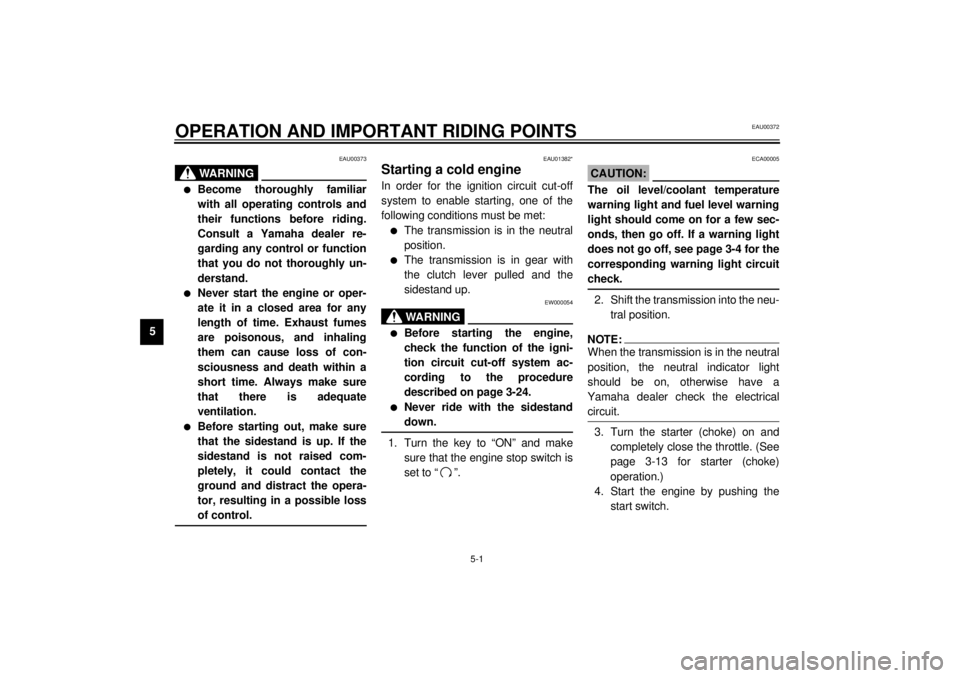
5-1
5
EAU00372
5-OPERATION AND IMPORTANT RIDING POINTS
EAU00373
WARNING
@ l
Become thoroughly familiar
with all operating controls and
their functions before riding.
Consult a Yamaha dealer re-
garding any control or function
that you do not thoroughly un-
derstand.
l
Never start the engine or oper-
ate it in a closed area for any
length of time. Exhaust fumes
are poisonous, and inhaling
them can cause loss of con-
sciousness and death within a
short time. Always make sure
that there is adequate
ventilation.
l
Before starting out, make sure
that the sidestand is up. If the
sidestand is not raised com-
pletely, it could contact the
ground and distract the opera-
tor, resulting in a possible loss
of control.
@
EAU01382*
Starting a cold engine In order for the ignition circuit cut-off
system to enable starting, one of the
following conditions must be met:l
The transmission is in the neutral
position.
l
The transmission is in gear with
the clutch lever pulled and the
sidestand up.
EW000054
WARNING
@ l
Before starting the engine,
check the function of the igni-
tion circuit cut-off system ac-
cording to the procedure
described on page 3-24.
l
Never ride with the sidestand
down.
@1. Turn the key to “ON” and make
sure that the engine stop switch is
set to “ ”.
ECA00005
CAUTION:@ The oil level/coolant temperature
warning light and fuel level warning
light should come on for a few sec-
onds, then go off. If a warning light
does not go off, see page 3-4 for the
corresponding warning light circuit
check. @2. Shift the transmission into the neu-
tral position.NOTE:@ When the transmission is in the neutral
position, the neutral indicator light
should be on, otherwise have a
Yamaha dealer check the electrical
circuit. @3. Turn the starter (choke) on and
completely close the throttle. (See
page 3-13 for starter (choke)
operation.)
4. Start the engine by pushing the
start switch.
E_5mt.book Page 1 Monday, September 18, 2000 9:08 AM
Page 49 of 118
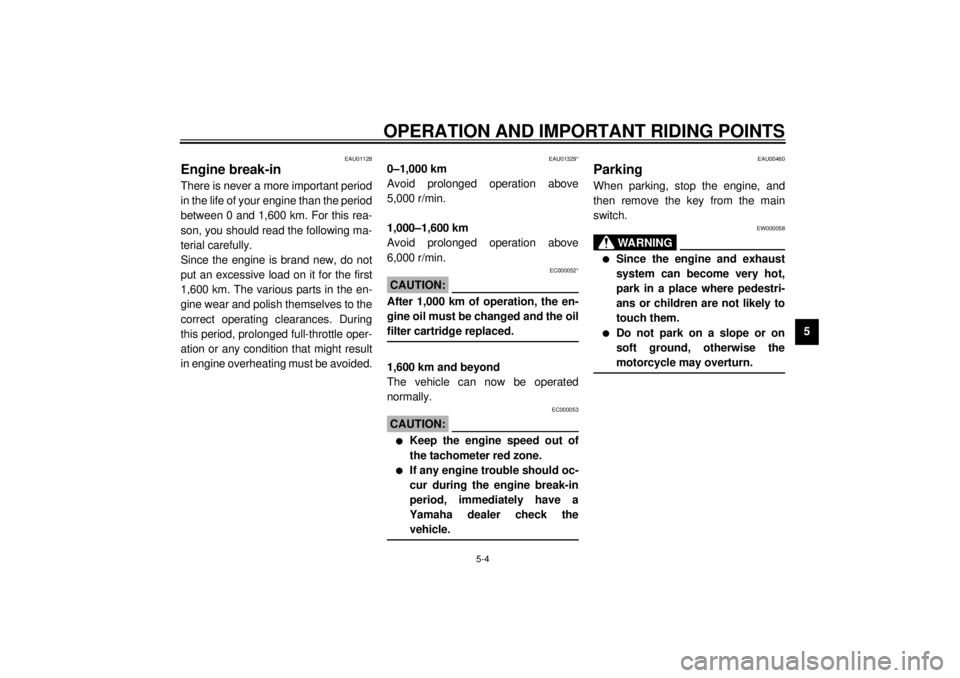
OPERATION AND IMPORTANT RIDING POINTS
5-4
5
EAU01128
Engine break-in There is never a more important period
in the life of your engine than the period
between 0 and 1,600 km. For this rea-
son, you should read the following ma-
terial carefully.
Since the engine is brand new, do not
put an excessive load on it for the first
1,600 km. The various parts in the en-
gine wear and polish themselves to the
correct operating clearances. During
this period, prolonged full-throttle oper-
ation or any condition that might result
in engine overheating must be avoided.
EAU01329*
0–1,000 km
Avoid prolonged operation above
5,000 r/min.
1,000–1,600 km
Avoid prolonged operation above
6,000 r/min.
EC000052*
CAUTION:@ After 1,000 km of operation, the en-
gine oil must be changed and the oil
filter cartridge replaced. @1,600 km and beyond
The vehicle can now be operated
normally.
EC000053
CAUTION:@ l
Keep the engine speed out of
the tachometer red zone.
l
If any engine trouble should oc-
cur during the engine break-in
period, immediately have a
Yamaha dealer check the
vehicle.
@
EAU00460
Parking When parking, stop the engine, and
then remove the key from the main
switch.
EW000058
WARNING
@ l
Since the engine and exhaust
system can become very hot,
park in a place where pedestri-
ans or children are not likely to
touch them.
l
Do not park on a slope or on
soft ground, otherwise the
motorcycle may overturn.
@
E_5mt.book Page 4 Monday, September 18, 2000 9:08 AM
Page 51 of 118
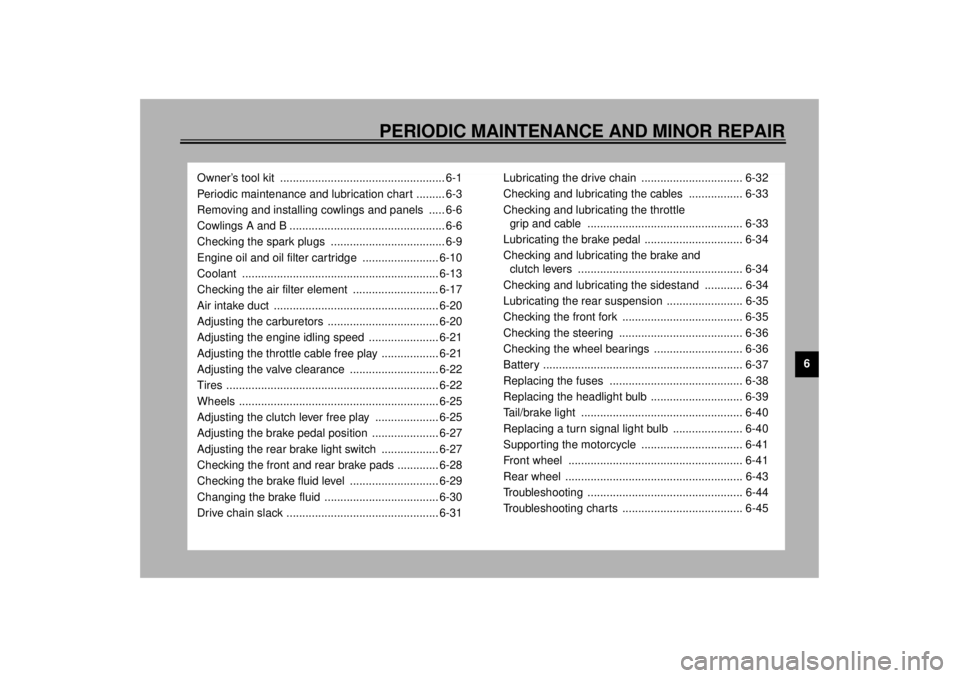
6
PERIODIC MAINTENANCE AND MINOR REPAIR
Owner’s tool kit .................................................... 6-1
Periodic maintenance and lubrication chart ......... 6-3
Removing and installing cowlings and panels ..... 6-6
Cowlings A and B ................................................. 6-6
Checking the spark plugs .................................... 6-9
Engine oil and oil filter cartridge ........................ 6-10
Coolant .............................................................. 6-13
Checking the air filter element ........................... 6-17
Air intake duct .................................................... 6-20
Adjusting the carburetors ................................... 6-20
Adjusting the engine idling speed ...................... 6-21
Adjusting the throttle cable free play .................. 6-21
Adjusting the valve clearance ............................ 6-22
Tires ................................................................... 6-22
Wheels ............................................................... 6-25
Adjusting the clutch lever free play .................... 6-25
Adjusting the brake pedal position ..................... 6-27
Adjusting the rear brake light switch .................. 6-27
Checking the front and rear brake pads ............. 6-28
Checking the brake fluid level ............................ 6-29
Changing the brake fluid .................................... 6-30
Drive chain slack ................................................ 6-31Lubricating the drive chain ................................ 6-32
Checking and lubricating the cables ................. 6-33
Checking and lubricating the throttle
grip and cable ................................................. 6-33
Lubricating the brake pedal ............................... 6-34
Checking and lubricating the brake and
clutch levers .................................................... 6-34
Checking and lubricating the sidestand ............ 6-34
Lubricating the rear suspension ........................ 6-35
Checking the front fork ...................................... 6-35
Checking the steering ....................................... 6-36
Checking the wheel bearings ............................ 6-36
Battery ............................................................... 6-37
Replacing the fuses .......................................... 6-38
Replacing the headlight bulb ............................. 6-39
Tail/brake light ................................................... 6-40
Replacing a turn signal light bulb ...................... 6-40
Supporting the motorcycle ................................ 6-41
Front wheel ....................................................... 6-41
Rear wheel ........................................................ 6-43
Troubleshooting ................................................. 6-44
Troubleshooting charts ...................................... 6-45
E_5mt.book Page 1 Monday, September 18, 2000 9:08 AM
Page 56 of 118
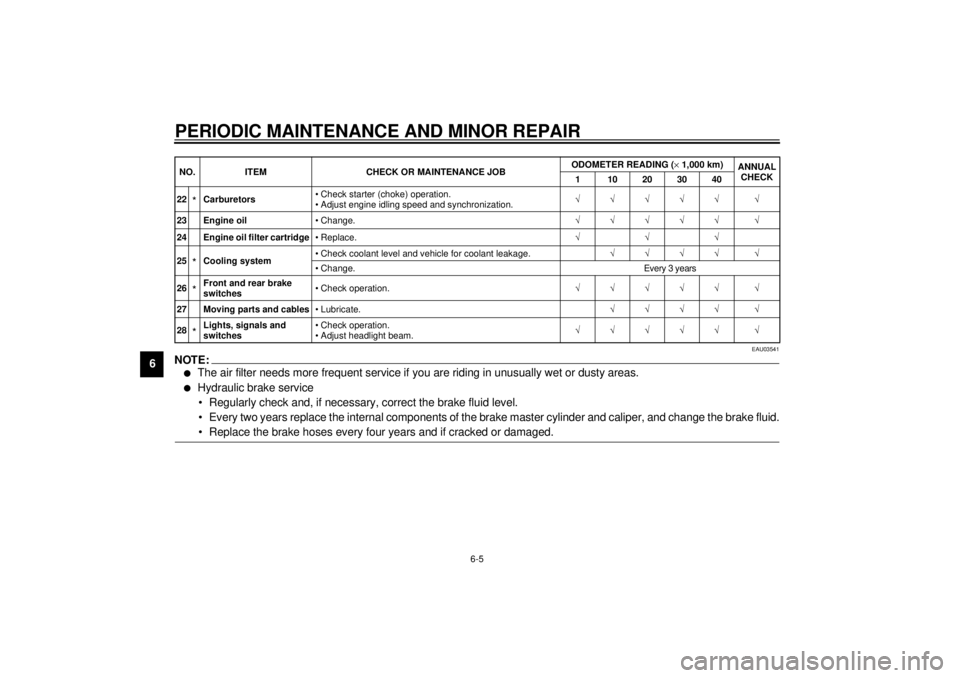
PERIODIC MAINTENANCE AND MINOR REPAIR
6-5
6
EAU03541
NOTE:@l
The air filter needs more frequent service if you are riding in unusually wet or dusty areas.
l
Hydraulic brake service
• Regularly check and, if necessary, correct the brake fluid level.
• Every two years replace the internal components of the brake master cylinder and caliper, and change the brake fluid.
• Replace the brake hoses every four years and if cracked or damaged.
@22
*Carburetors• Check starter (choke) operation.
• Adjust engine idling speed and synchronization.ÖÖÖÖÖ Ö
23 Engine oil• Change.ÖÖÖÖÖ Ö
24 Engine oil filter cartridge•Replace.ÖÖÖ
25*Cooling system• Check coolant level and vehicle for coolant leakage.ÖÖÖÖ Ö
• Change. Every 3 years
26*Front and rear brake
switches• Check operation.ÖÖÖÖÖ Ö
27 Moving parts and cables• Lubricate.ÖÖÖÖ Ö
28*Lights, signals and
switches• Check operation.
• Adjust headlight beam.ÖÖÖÖÖ Ö NO. ITEM CHECK OR MAINTENANCE JOBODOMETER READING (´1,000 km)
ANNUAL
CHECK
1 10203040
E_5mt_Periodic.fm Page 5 Tuesday, December 12, 2000 5:49 PM